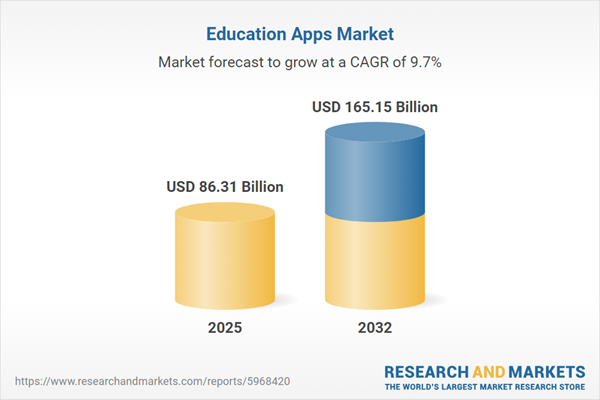Speak directly to the analyst to clarify any post sales queries you may have.
The Education Apps Market is undergoing rapid transformation, with digital learning tools now central to educational delivery for institutions and lifelong learners alike. Supported by advancements in mobile technology and evolving pedagogical approaches, education applications continue to reshape learning landscapes worldwide.
Market Snapshot: Education Apps Market Size and Growth
The global Education Apps Market grew from USD 78.57 billion in 2024 to USD 86.31 billion in 2025, and is projected to continue its expansion at a CAGR of 9.72%, reaching USD 165.15 billion by 2032. This growth reflects rising adoption across educational, corporate, and lifelong learning contexts, as organizations and educators prioritize scalability, accessibility, and dynamic skill development.
Scope & Segmentation of the Education Apps Market
This research offers comprehensive coverage and actionable insights into the multifaceted structure of the education applications sector. Segments are analyzed by application types, subjects, monetization strategies, device preferences, delivery models, platform ecosystems, and geographic regions.
- App Types: Coding, K-12 Supplemental, Language Learning, Learning Management Systems (Cloud Based, On Premise), Skill Development, STEM Education, Test Preparation
- Subject Areas: Arts, Coding, Language, Mathematics, Science
- Monetization Models: Advertisement, Freemium, In-App Purchase, Pay-Per-Download, Subscription (Annual, Monthly)
- Device Types: PC/Laptop, Smartphones, Tablets
- Delivery Modes: Offline, Online (Live Stream, Self Paced)
- Platforms: Android, iOS, Web
- Regions: Americas (North America - United States, Canada, Mexico; Latin America - Brazil, Argentina, Chile, Colombia, Peru), Europe Middle East & Africa (Europe - United Kingdom, Germany, France, Russia, Italy, Spain, Netherlands, Sweden, Poland, Switzerland; Middle East - United Arab Emirates, Saudi Arabia, Qatar, Turkey, Israel; Africa - South Africa, Nigeria, Egypt, Kenya), Asia-Pacific (China, India, Japan, Australia, South Korea, Indonesia, Thailand, Malaysia, Singapore, Taiwan)
- Key Companies: Think & Learn Pvt. Ltd., TAL Education Group, New Oriental Education & Technology Group, Pearson plc, Chegg, Inc., Duolingo, Inc., Coursera, Inc., 2U, Inc., Udemy, Inc., Kahoot! AS
Key Takeaways for Senior Decision Makers
- Education app providers are leveraging artificial intelligence and machine learning to offer personalized, adaptive learning experiences tailored to user performance and engagement.
- Cloud-based architectures underpin scalable and flexible learning management solutions, with immersive technologies like augmented and virtual reality gaining traction for interactive subject delivery.
- User engagement models now emphasize gamification, real-time collaboration, and social learning features, driving sustained platform usage and pedagogical innovation.
- Diverse monetization strategies, including freemium, advertising, and subscription-based models, enable providers to cater to a broader user base while balancing accessibility with revenue optimization.
- Regional diversity in infrastructure, regulatory frameworks, and digital literacy necessitates distinctly localized go-to-market strategies and content adaptation.
Tariff Impact on Education App Supply Chains and Pricing
New tariffs introduced in 2025 have affected supply chains for digital devices and software licenses, leading to increased manufacturing and licensing costs. In response, providers are adapting pricing structures, optimizing contracts, and accelerating the localization of content and partnerships to manage compliance and cost pressures. Strategic collaboration with domestic service providers and a focus on regional standards have become more prominent in market adaptation efforts.
Methodology & Data Sources
This analysis employs a robust combination of primary and secondary research. It includes expert interviews, stakeholder surveys, and reviews of industry publications, academic sources, and proprietary data. Data triangulation techniques and both quantitative and qualitative analyses ensure reliability and comprehensive market insights.
Why This Report Matters: Strategic Value for Education Sector Leaders
- Enables informed product development and investment strategies by highlighting critical market drivers, segment nuances, and regional dynamics.
- Empowers stakeholders to respond effectively to regulatory, technological, and competitive shifts in education application adoption and delivery models.
Conclusion
The education apps market is evolving through digital innovation, adaptive learning, and shifting regulatory landscapes. Leaders equipped with data-driven insights can leverage emerging opportunities and navigate future challenges in this dynamic sector.
Additional Product Information:
- Purchase of this report includes 1 year online access with quarterly updates.
- This report can be updated on request. Please contact our Customer Experience team using the Ask a Question widget on our website.
Table of Contents
3. Executive Summary
4. Market Overview
7. Cumulative Impact of Artificial Intelligence 2025
Companies Mentioned
The companies profiled in this Education Apps market report include:- Think & Learn Pvt. Ltd.
- TAL Education Group
- New Oriental Education & Technology Group
- Pearson plc
- Chegg, Inc.
- Duolingo, Inc.
- Coursera, Inc.
- 2U, Inc.
- Udemy, Inc.
- Kahoot! AS
Table Information
| Report Attribute | Details |
|---|---|
| No. of Pages | 189 |
| Published | October 2025 |
| Forecast Period | 2025 - 2032 |
| Estimated Market Value ( USD | $ 86.31 Billion |
| Forecasted Market Value ( USD | $ 165.15 Billion |
| Compound Annual Growth Rate | 9.7% |
| Regions Covered | Global |
| No. of Companies Mentioned | 11 |









